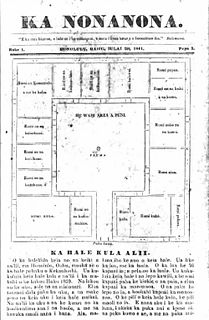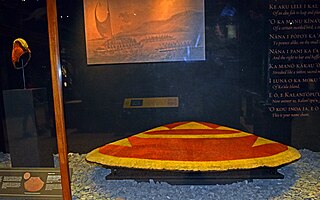Related Research Articles

Geometry of numbers is the part of number theory which uses geometry for the study of algebraic numbers. Typically, a ring of algebraic integers is viewed as a lattice in and the study of these lattices provides fundamental information on algebraic numbers. The geometry of numbers was initiated by Hermann Minkowski (1910).

The Royal Statistical Society (RSS) is an established statistical society. It has three main roles: a British learned society for statistics, a professional body for statisticians and a charity which promotes statistics for the public good.

The Royal School is a historic school founded in 1839 in Honolulu, Hawaiʻi, as the Chiefs' Children's School. The school was renamed as the Royal School in 1846. After the boarding closed in 1850, it became a day school for children. It later became a public elementary school, and moved to its present campus in 1967.

Kawaiahaʻo Church is a historic Congregational church located in Downtown Honolulu on the Hawaiian Island of Oʻahu. The church, along with the Mission Houses, comprise the Hawaiian Mission Houses Historic Site, which was designated a U.S. National Historic Landmark (NHL) in 1962. In 1966 it and all other NHLs were included in the first issuance of the National Register of Historic Places.

Kaumualiʻi was the last independent aliʻi nui of Kauaʻi and Niʻihau before becoming a vassal of Kamehameha I within the unified Kingdom of Hawaiʻi in 1810. He was the 23rd high chief of Kauaʻi and reigned during 1794–1810.

Ancient Hawaiʻi is the period of Hawaiian human history preceding the unification in 1810 of the Kingdom of Hawaiʻi by Kamehameha the Great. Traditionally researchers estimated the first settlement of the Hawaiian islands as having occurred sporadically between 300 and 800 CE by Polynesian long-distance navigators from the Samoan Islands and the Marquesas Islands, Tuamotus, and the Society Islands within what is now French Polynesia. In 2010, a study was published based on radiocarbon dating of more reliable samples which suggests that the islands were settled much later, within a short timeframe, in about 1219 to 1266.
The aliʻi were the traditional nobility of the Hawaiian islands. They were part of a hereditary line of rulers, the noho aliʻi.

The Huliheʻe Palace is located in historic Kailua-Kona, Hawaiʻi, on Ali'i Drive. The former vacation home of Hawaiian royalty, it was converted to a museum run by the Daughters of Hawaiʻi, showcasing furniture and artifacts. It is located at 75–5718 Aliʻi Drive, Kailua-Kona.
The Great Māhele or just the Māhele was the Hawaiian land redistribution proposed by King Kamehameha III. The Great Māhele was one of the most important episodes of Hawaiian history, second only to the overthrow of the Hawaiian Kingdom. While intended to provide secure title to Hawaiians, it would eventually end up separating many of them from their land.

Kalaniʻōpuʻu-a-Kaiamamao was the aliʻi nui of the island of Hawaiʻi. He was called Terreeoboo, King of Owhyhee by James Cook and other Europeans. His name has also been written as Kaleiopuu.

The Legislature of the Hawaiian Kingdom was the bicameral legislature of the Hawaiian Kingdom. A royal legislature was first provided by the 1840 Constitution and the 1852 Constitution was the first to use the term Legislature of the Hawaiian Islands, and the first to subject the monarch to certain democratic principles. Prior to this the monarchs ruled under a Council of Chiefs.
Keakamāhana was an aliʻi nui of Hawaiʻi Island from 1635 to 1665. She ruled as sovereign of the island from the royal complex at Hōlualoa Bay.
The following is a list of Aliʻi nui of Hawaiʻi.
Keliʻiokaloa (1500–1545) was the Aliʻi nui of the island of Hawaiʻi from 1525 to 1545. He was the sovereign king or chief of the island of Hawaiʻi.
The aliʻi nui of Kauaʻi was the sovereign king or queen of the islands of Kauaʻi and Niʻihau.
The Aliʻi nui of Maui was the supreme ruler of the islands of Maui, one of the four main Hawaiian Islands as well as the smaller island of Lanai. The title is the same as that of the Aliʻi nui of the other islands. The title or phrase Mōʻī is sometimes used for the title of the monarchs of Maui; however, it is not an ancient word in the Hawaiian language and has origins in the mid 19th century. The only monarchs to officially hold the title of Mōʻī are Kalākaua and his sister Liliuokalani.
The Aliʻi nui were high chiefs of the four main Hawaiian Islands. The rulers of Molokaʻi, like those of the other Hawaiian islands, claim descent from god Wākea.

Shifford is a hamlet in the civil parish of Aston, Cote, Shifford and Chimney in Oxfordshire, England. It is on the north bank of the River Thames about 6 miles (10 km) south of Witney.

Royal York Collegiate Institute is a former public high school existed from 1953–1982 under the Etobicoke Board of Education in The Queensway – Humber Bay neighbourhood of the Etobicoke district in Toronto, Ontario, Canada. It was the first academic high school built in Etobicoke after World War II.
Līloa was a legendary ruler of the island of Hawaii in the late 15th century. He kept his royal compound in Waipi'o Valley.